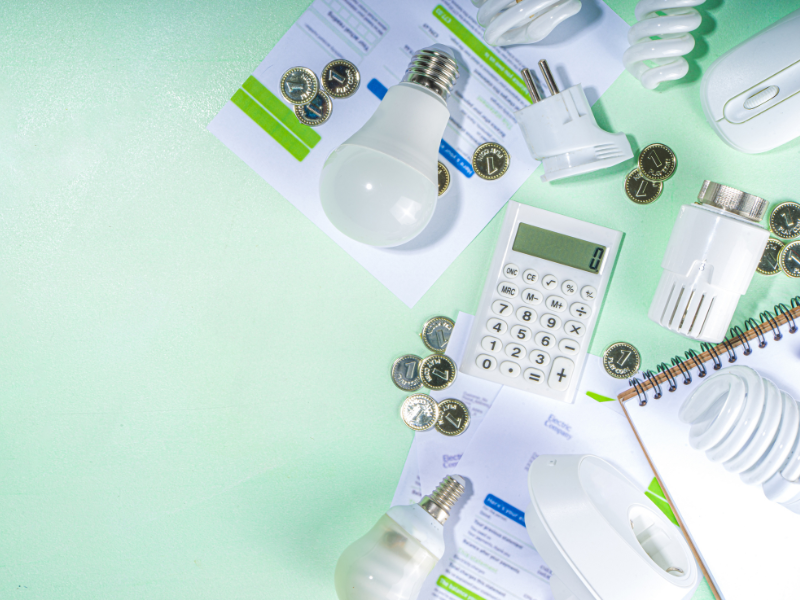Introduction
Welcome to this comprehensive guide on energy cost savings with renewable sources! In today’s world, where energy consumption is at an all-time high and concerns about climate change are pressing, finding alternative sources of energy that are sustainable and economical is crucial. Renewable energy sources provide an environmentally friendly and cost-effective solution to meet our growing energy needs. In this article, we will explore the various types of renewable energy sources, their benefits, and how they can contribute to significant savings on energy costs.
What are renewable energy sources?

Renewable energy sources are natural resources that replenish themselves over time and have the ability to generate electricity or heat. Unlike fossil fuels such as coal, oil, and natural gas, which are finite and contribute to greenhouse gas emissions and air pollution, renewable energy sources are abundant and produce little to no emissions. By harnessing the power of renewable energy, we can reduce our reliance on non-renewable resources and mitigate the harmful impacts of traditional energy sources on the environment.
Benefits of renewable energy sources

Renewable energy sources offer numerous benefits compared to traditional energy sources. Some of these include:
- Environmental sustainability: Renewable energy sources produce little to no greenhouse gas emissions, helping to combat climate change and reduce air pollution. They also have a lower impact on natural ecosystems compared to fossil fuel extraction and burning.
- Energy independence: By diversifying our energy sources and relying on renewable energy, countries can reduce their dependence on imported fossil fuels. This enhances energy security and promotes domestic economic growth.
- Economic opportunities: The renewable energy sector has the potential to create millions of jobs worldwide. From manufacturing and installation to maintenance and research, renewable energy projects can stimulate local economies and contribute to job growth.
- Energy cost savings: Renewable energy sources can help reduce electricity bills for both residential and commercial consumers. As technologies continue to advance and economies of scale are realized, the cost of renewable energy generation has become increasingly competitive with traditional energy sources.
- Long-term viability: Unlike fossil fuels, which are finite resources, renewable energy sources have the potential to meet our energy needs indefinitely. By investing in renewable energy now, we can ensure a sustainable and reliable energy future for generations to come.
Types of renewable energy sources
There are several types of renewable energy sources, each with its unique characteristics and applications. Let’s explore some of the most common ones:

Solar energy: Harnessing the power of the sun
Solar energy is derived from the sun’s radiation and can be converted into electricity using photovoltaic (PV) cells or concentrated solar power (CSP) systems. PV cells directly convert sunlight into electricity, while CSP systems use mirrors or lenses to concentrate solar energy and generate heat, which is then converted into electricity. Solar energy is a versatile and abundant resource, making it one of the fastest-growing renewable energy sources globally.
Wind energy: Capturing the breeze for electricity
Wind energy is harvested by wind turbines, which convert the kinetic energy of the wind into electrical energy. As the wind blows, it causes the turbine’s blades to rotate, generating electricity. Wind energy is a clean and scalable power source that can be harnessed onshore or offshore. It has the potential to supply a significant portion of our electricity needs, especially in regions with favorable wind conditions.
Hydropower: Harnessing the power of water
Hydropower, also known as hydroelectric power, is generated by the gravitational force of falling or flowing water. Water is stored in reservoirs behind dams, and when released, it flows through turbines, spinning them and generating electricity. Hydropower is a mature and reliable renewable energy source, accounting for a significant portion of global electricity generation. It offers flexibility in terms of capacity and can store excess energy for future use.
Geothermal energy: Tapping into the Earth’s heat
Geothermal energy is obtained by tapping into the Earth’s natural heat. It involves using heat from the Earth’s core to generate steam or hot water, which is then used to power turbines and produce electricity. Geothermal energy is a reliable and constant source of power, available 24/7. It is especially suitable for regions with high geothermal activity, such as volcanic areas.
Biomass energy: Utilizing organic matter for power
Biomass energy is derived from organic matter, such as wood, agricultural residues, and dedicated energy crops. These materials are burned or converted into biogas through the process of anaerobic digestion, which can then be used to generate electricity or produce heat. Biomass energy is considered carbon-neutral since the carbon dioxide emitted during combustion is offset by the carbon absorbed by plants during their growth.
Energy cost savings with renewable sources: A green alternative

As the demand for energy continues to rise, finding cost-effective solutions becomes increasingly important. Renewable energy sources offer a green alternative to traditional energy sources, with the potential for significant cost savings. By transitioning to renewable energy, individuals, businesses, and governments can reduce their energy costs while contributing to a more sustainable future.
Transitioning from traditional energy sources
Transitioning from traditional energy sources to renewable energy requires careful planning and consideration. It involves assessing energy needs, identifying suitable renewable energy sources, and implementing the necessary infrastructure and technologies. Governments can play a crucial role by providing policy support, financial incentives, and regulatory frameworks that encourage the adoption of renewable energy.
Energy cost savings with solar power
Solar power presents an excellent opportunity for energy cost savings. The cost of solar panels has decreased significantly in recent years, making them more accessible to homeowners and businesses. By installing solar panels, individuals and organizations can generate their electricity and reduce their reliance on the grid. Excess energy produced can be fed back into the grid, earning credits or incentives from electricity providers.
In addition to reducing electricity bills, solar power can also provide long-term cost stability. Unlike traditional energy sources, which are subject to price volatility, solar power systems generate electricity at a fixed cost over their lifespan. This can provide peace of mind to consumers and hedge against rising energy prices.
Energy cost savings with wind power
Wind power offers substantial cost savings potential, particularly in regions with favorable wind conditions. The cost of wind turbines has decreased in recent years, making wind energy increasingly competitive with fossil fuel-based electricity generation. Like solar power, wind power provides long-term cost stability, as it does not rely on fluctuating fuel prices.
Large-scale wind farms can contribute to significant energy cost savings at the utility level. By integrating wind power into the grid, utilities can reduce their dependence on expensive and polluting fossil fuel power plants. This, in turn, can lead to lower electricity prices for consumers.
Energy cost savings with hydropower
Hydropower is one of the most cost-effective renewable energy sources, with low operational and maintenance costs. While the upfront capital investment for building hydropower plants can be significant, the long-term cost savings outweigh the initial expenses. Once constructed, hydropower plants have a lifespan of several decades, providing a reliable and predictable source of electricity.
Hydropower plants also offer flexibility in terms of operation. They can respond to fluctuations in electricity demand by quickly adjusting the flow of water through turbines. This allows utilities to optimize energy generation based on market conditions, leading to potential cost savings.
Energy cost savings with geothermal power
Geothermal power plants have relatively low operational costs compared to traditional power plants. Geothermal energy is a constant and reliable source of power, making it a viable option for base-load electricity generation. Once a geothermal power plant is constructed, the cost of fuel is practically eliminated, resulting in long-term cost savings.
In regions with significant geothermal resources, such as volcanic areas, geothermal power can provide substantial energy cost savings. It offers a stable and predictable source of electricity, reducing the need to rely on imported fossil fuels and energy price fluctuations.
Energy cost savings with biomass energy
Biomass energy can contribute to energy cost savings by providing an alternative to fossil fuels for heat and power generation. Biomass fuels, such as wood pellets or agricultural residues, are often cheaper and more readily available than traditional fuel sources. By utilizing biomass energy, individuals and businesses can reduce their reliance on expensive fossil fuels and potentially lower their energy costs.
In addition to cost savings, biomass energy can also have economic benefits for rural communities. It supports local agriculture, forestry, and waste management industries, creating jobs and stimulating local economies.
Factors that impact energy cost savings
Several factors can influence the potential energy cost savings with renewable sources:
- Resource availability: The availability and intensity of renewable energy resources, such as sunlight, wind, water, geothermal heat, and biomass, can vary depending on location. Areas with abundant and consistent resources are more likely to achieve higher energy cost savings.
- Installation and maintenance costs: The upfront costs of installing renewable energy systems, such as solar panels or wind turbines, can vary depending on the scale and complexity of the project. Ongoing maintenance and operation costs should also be considered when evaluating the overall cost savings.
- System efficiency: The efficiency of renewable energy systems, such as the conversion rate of sunlight to electricity in solar panels or the capacity factor of wind turbines, can impact energy cost savings. Higher efficiency systems can generate more electricity from the same input of renewable resources, resulting in greater cost savings.
- Energy consumption patterns: The energy consumption patterns of individuals, businesses, and governments play a significant role in determining the potential cost savings with renewable energy. Energy-efficient practices and technologies can further enhance the overall savings.
Government incentives for renewable energy
Many governments around the world offer various incentives to promote the adoption of renewable energy. These incentives aim to overcome the initial cost barriers associated with renewable energy projects and accelerate their deployment. Some common government incentives include:
- Feed-in tariffs: Feed-in tariffs guarantee a fixed payment rate for the electricity generated from renewable sources. This allows renewable energy producers to sell their electricity to the grid at a premium price, ensuring a return on their investment.
- Tax credits and rebates: Tax credits and rebates provide financial incentives to individuals and businesses that install renewable energy systems. They can offset a portion of the upfront costs and reduce the payback period for renewable energy projects.
- Grants and subsidies: Governments may offer grants and subsidies to support the development and implementation of renewable energy projects. These funds can be used to cover a portion of the project’s costs or provide financial support for research and development.
- Renewable portfolio standards: Renewable portfolio standards require utilities to obtain a certain percentage of their electricity from renewable sources. Utilities that fail to meet these standards may face penalties or additional fees. This creates a market demand for renewable energy and encourages investment in renewable energy projects.
Financing options for renewable energy projects
In addition to government incentives, there are various financing options available for renewable energy projects:
- Power purchase agreements (PPAs): PPAs allow individuals or businesses to purchase renewable electricity directly from a project developer. Under a PPA, the developer owns and operates the renewable energy system, while the consumer agrees to purchase the electricity generated at a predetermined price. PPAs provide a long-term fixed price for electricity, reducing the financial risks associated with fluctuating energy prices.
- Green bonds: Green bonds are a type of debt instrument issued by governments, municipalities, or corporations to finance environmentally friendly projects, including renewable energy projects. Investors purchase these bonds, and the proceeds are used to fund qualifying projects. Green bonds provide a stable and long-term source of capital for renewable energy projects.
- Energy performance contracts (EPCs): EPCs are agreements between an energy services company (ESCO) and a consumer, where the ESCO guarantees a certain level of energy savings. The ESCO identifies and implements energy efficiency measures or renewable energy systems and shares a portion of the savings with the consumer. EPCs provide a way for consumers to finance renewable energy projects without significant upfront costs.
- Crowdfunding: Crowdfunding platforms allow individuals to invest or donate money towards renewable energy projects. This decentralized financing model enables small-scale investors to support renewable energy initiatives and gain financial returns or rewards in return.
Case studies: Real-world examples of energy cost savings
Looking at real-world examples can provide valuable insights into the energy cost savings potential of renewable sources. Here are two case studies:
Case Study 1: The Solar Renaissance in Germany
Germany has experienced a solar renaissance over the past decade, driven by favorable government policies and declining solar panel prices. As a result, the country has become a global leader in solar energy adoption.
The city of Freiburg, located in southern Germany, has embraced solar power as a significant source of electricity generation. The city has installed solar panels on residential rooftops, commercial buildings, and even public facilities like schools and municipal buildings. The abundant sunshine and comprehensive solar policies have enabled Freiburg to generate a significant portion of its electricity from solar power.
This widespread adoption of solar energy has resulted in energy cost savings for residents and businesses in Freiburg. By investing in solar panels, individuals can produce their electricity and reduce their reliance on the grid. The excess energy generated can be sold back to the grid, resulting in additional cost savings.
Case Study 2: Wind Farms in Denmark
Denmark is known for its strong commitment to renewable energy, particularly wind power. The country has been investing in wind farms since the 1970s and has become a global leader in wind energy generation.
The wind farms in Denmark, both onshore and offshore, have contributed significantly to the country’s energy cost savings. By harnessing wind power, Denmark has reduced its reliance on imported fossil fuels and achieved a stable and reliable source of electricity.
The energy cost savings realized through wind power have benefited both individual consumers and the broader economy. Electricity prices have remained stable, and consumers have enjoyed lower energy bills compared to countries heavily reliant on traditional energy sources. Additionally, the wind energy sector has created numerous job opportunities and contributed to economic growth.
Common misconceptions about renewable energy
Despite the numerous benefits of renewable energy, there are several common misconceptions that persist. Let’s address some of these misconceptions:
Myth: Renewable energy is too expensive.
Fact: While the upfront costs of renewable energy systems can be higher compared to traditional energy sources, the long-term cost savings and environmental benefits outweigh the initial investment. As technology advances and economies of scale are realized, the cost of renewable energy continues to decline.
Myth: Renewable energy is unreliable.
Fact: Renewable energy sources can provide a reliable and predictable power supply. Advanced forecasting and energy storage technologies help manage fluctuations in resource availability, ensuring a stable electricity output. Additionally, a diversified portfolio of renewable energy sources helps mitigate the impact of intermittency on energy supply.
Myth: Renewable energy cannot meet our energy needs.
Fact: Renewable energy has the potential to meet a significant portion of our energy needs. By combining different types of renewable energy sources, optimizing energy efficiency, and implementing energy storage technologies, we can achieve a reliable and sustainable energy future. Numerous studies have demonstrated the feasibility of high levels of renewable energy integration.
Myth: Renewable energy is only suitable for certain regions.
Fact: While resource availability may vary by location, renewable energy sources can be harnessed in different geographical areas. Solar power can be generated even in regions with less sunlight, and wind power can be tapped into both onshore and offshore. Moreover, interconnected grids and long-distance transmission can facilitate the sharing of renewable energy across regions.
Frequently asked questions about energy cost savings with renewable sources
Q: How can I determine the potential energy cost savings with renewable sources for my home or business?
A: Several factors need to be considered, such as your energy consumption, location, available resources, and upfront investment. Consulting with a renewable energy expert or conducting an energy audit can help assess the feasibility and potential savings of renewable energy solutions.
Q: Are there any financial incentives available to support renewable energy projects?
A: Yes, many governments offer incentives such as feed-in tariffs, tax credits, rebates, and grants to promote the adoption of renewable energy. Additionally, financing options like power purchase agreements, green bonds, and energy performance contracts can help fund renewable energy projects.
Q: How long does it take to recoup the upfront costs of installing renewable energy systems?
A: The payback period for renewable energy systems varies depending on factors such as the type of system, energy consumption, local electricity rates, and available incentives. In general, most residential solar power systems have a payback period of around 5 to 10 years.
Q: Can renewable energy systems generate excess electricity?
A: Yes, renewable energy systems like solar panels and wind turbines can generate more electricity than needed at certain times. Excess electricity can be stored in batteries or fed back into the grid, earning credits or incentives from electricity providers.
Conclusion
The transition to renewable energy sources offers significant energy cost savings, environmental benefits, and long-term viability. Solar power, wind power, hydropower, geothermal energy, and biomass energy provide viable alternatives to traditional energy sources and offer numerous economic opportunities. Governments, businesses, and individuals can contribute to a more sustainable future by embracing renewable energy and reducing their reliance on fossil fuels.
With the right policies, financial incentives, and investments, we can create a cleaner and more affordable energy landscape for future generations. Start exploring the benefits of renewable energy today and unlock the potential for energy cost savings while building a sustainable future.




